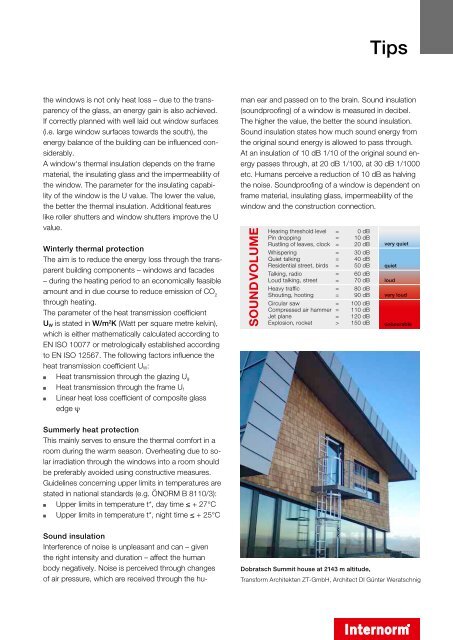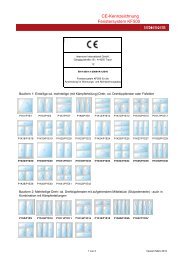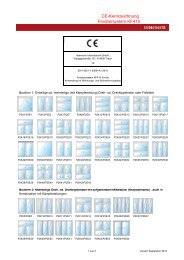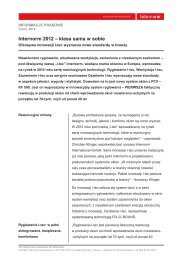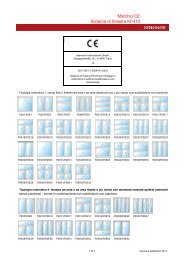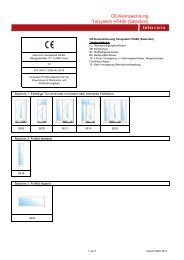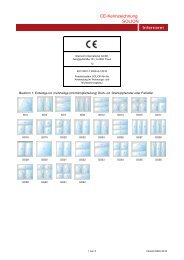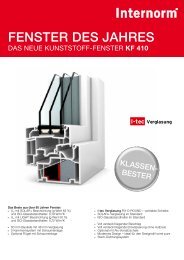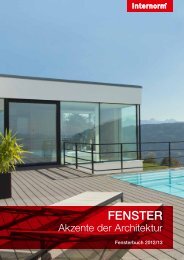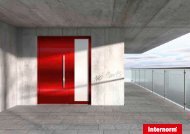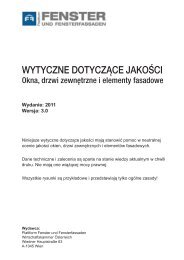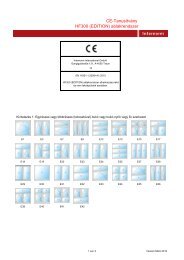WINDOWS - Internorm-Fenster AG
WINDOWS - Internorm-Fenster AG
WINDOWS - Internorm-Fenster AG
You also want an ePaper? Increase the reach of your titles
YUMPU automatically turns print PDFs into web optimized ePapers that Google loves.
the windows is not only heat loss – due to the transparency<br />
of the glass, an energy gain is also achieved.<br />
If correctly planned with well laid out window surfaces<br />
(i.e. large window surfaces towards the south), the<br />
energy balance of the building can be influenced considerably.<br />
A window‘s thermal insulation depends on the frame<br />
material, the insulating glass and the impermeability of<br />
the window. The parameter for the insulating capability<br />
of the window is the u value. The lower the value,<br />
the better the thermal insulation. Additional features<br />
like roller shutters and window shutters improve the u<br />
value.<br />
Winterly thermal protection<br />
The aim is to reduce the energy loss through the transparent<br />
building components – windows and facades<br />
– during the heating period to an economically feasible<br />
amount and in due course to reduce emission of CO 2<br />
through heating.<br />
The parameter of the heat transmission coefficient<br />
UW is stated in W/m 2 K (Watt per square metre kelvin),<br />
which is either mathematically calculated according to<br />
EN ISO 10077 or metrologically established according<br />
to EN ISO 12567. The following factors influence the<br />
heat transmission coefficient uW:<br />
Heat transmission through the glazing ug<br />
Heat transmission through the frame uf<br />
Linear heat loss coefficient of composite glass<br />
edge y<br />
Summerly heat protection<br />
This mainly serves to ensure the thermal comfort in a<br />
room during the warm season. Overheating due to solar<br />
irradiation through the windows into a room should<br />
be preferably avoided using constructive measures.<br />
Guidelines concerning upper limits in temperatures are<br />
stated in national standards (e.g. ÖNORM B 8110/3):<br />
upper limits in temperature t*, day time ≤ + 27°C<br />
upper limits in temperature t*, night time ≤ + 25°C<br />
Sound insulation<br />
Interference of noise is unpleasant and can – given<br />
the right intensity and duration – affect the human<br />
body negatively. Noise is perceived through changes<br />
of air pressure, which are received through the hu-<br />
Tips<br />
man ear and passed on to the brain. Sound insulation<br />
(soundproofing) of a window is measured in decibel.<br />
The higher the value, the better the sound insulation.<br />
Sound insulation states how much sound energy from<br />
the original sound energy is allowed to pass through.<br />
At an insulation of 10 dB 1/10 of the original sound energy<br />
passes through, at 20 dB 1/100, at 30 dB 1/1000<br />
etc. Humans perceive a reduction of 10 dB as halving<br />
the noise. Soundproofing of a window is dependent on<br />
frame material, insulating glass, impermeability of the<br />
window and the construction connection.<br />
SOUND VOLUME<br />
Hearing threshold level = 0 dB<br />
Pin dropping = 10 dB<br />
Rustling of leaves, clock = 20 dB<br />
Whispering = 30 dB<br />
Quiet talking = 40 dB<br />
Residential street, birds = 50 dB<br />
Talking, radio = 60 dB<br />
Loud talking, street = 70 dB<br />
Heavy traffic = 80 dB<br />
Shouting, hooting = 90 dB<br />
Circular saw = 100 dB<br />
Compressed air hammer = 110 dB<br />
Jet plane = 120 dB<br />
Explosion, rocket > 150 dB<br />
very quiet<br />
quiet<br />
loud<br />
very loud<br />
unbearable<br />
Dobratsch Summit house at 2143 m altitude,<br />
Transform Architekten ZT-GmbH, Architect DI Günter Weratschnig


